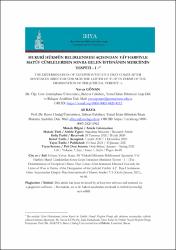HUKUKÎ HÜKMÜN BELİRLENMESİ AÇISINDAN VÂV HARFİYLE MATÛF CÜMLELERDEN SONRA GELEN İSTİSNÂNIN MERCİİNİN TESPİTİ – I –

View/
Access
Attribution 3.0 United Statesinfo:eu-repo/semantics/openAccesshttp://creativecommons.org/licenses/by/3.0/us/Date
2021Access
Attribution 3.0 United Statesinfo:eu-repo/semantics/openAccesshttp://creativecommons.org/licenses/by/3.0/us/Metadata
Show full item recordCitation
Gönan, Yavuz- Kaya, Ali “Hukukî Hükmün Belirlenmesi Açısından Vâv Harfiyle Matûf Cümlelerden Sonra Gelen İstisnânın Merciinin Tespiti – I – [The Determination of Exception’s Status That Comes After Sentences Directed Towards the Letter of Waw in Terms of the Designation of the Judicial Verdict -I-]”. İhya Uluslararası İslam Araştırmaları Dergisi- İhya International of Islamic Studies 7/1 (Ocak/January 2021), 46-68.Abstract
Hukukçunun elindeki en önemli malzeme hukuk normlarıdır. Bunlar da ait oldukları dilde ve o dilin kuralları doğrultusunda yazılmaktadır. İslam hukukunun kaynağı olan Kur’ân ve Sünnet nasları da Arapça olduğu için fakih, hukukî nasları yorumlarken Arapça dilbilgisi (nahiv) kurallarını dikkate almalıdır. Buna göre fakih; Arapça cümle yapısı şekillerinden biri olan istisnâ üslubunun kurallarını bilmeli ve hüküm istidlâlinde bu kuralları uygulamalıdır. İstisnâyla ilgili usûl-ı fıkıhtaki temel tartışma alanlarından biri de vâv ile matûf cümlelerden sonra gelen istisnânın merciinin tespitidir. Matûf cümlelerden sonra kullanılan istisnânın merciinin, yani müstesnâ minh’in, dilbilgisi kuralları doğrultusunda tespit edilmesi; istisnânın, hukukî hükmün teşekkülüne etkisinin belirlenmesi ve kurallarının uygulanması bakımından önem taşımaktadır. Bu nedenle çalışmamızda önce genel olarak usulcülerin konuyla ilgili teorik yaklaşımları, gerekçeleri ve çözümleri açıklanmış; ardından en-Nûr sûresinin 4-5. âyetleri bağlamında, görüşlerini uygulamalı olarak temellendirme çabaları ele alınmıştır The most important materials in the hands of the jurist are legal norms. Every norm that notifies judgment has written in its own language according to that language’s rules. The jurist of Islam should take into consideration the rules of the Arabic language’s grammar (nahw) while he is interpreting the judicial verdicts because the judicial verdicts of the Qur’an and the Sunnah which are the founder texts of Islamic law are the Arabic language. In accordance with that the jurist should know the rules of grammar of the exception wording that is one of the shape of structure of Arabic sentence and implement these rules in deduction of judgment. The one of the basic discussion field of usul al-fiqh about the exception wording is the determination of the exception’s status which comes after sentences directed towards waw. The determination of exception’s status which is used after directed sentences, in other words mustasna minh, according to the rules of grammar is of capital importance from the point of view of designation of the impression of exception to judicial verdict’s formation and judicial implemetation. Because of that reason, in our study firstly theoretical approaches, justifications and solutions of the precodurers have been explained; in the wake of that their efforts to establish firmly and practically their opinions in the context of the verse 4 and 5 of the Sûrat al-Nûr have been discussed.
Volume
7Issue
1Collections
The following license files are associated with this item:


















